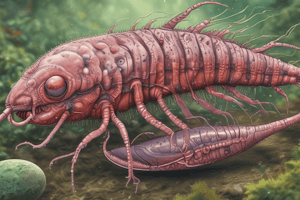Podcast
Questions and Answers
Describe the morphology of Hymenolepis nana eggs.
Describe the morphology of Hymenolepis nana eggs.
Oval with a thin wall, smaller than Hymenolepis diminuta eggs. Oncospheres have six hooks.
What are the symptoms of hymenolepiasis?
What are the symptoms of hymenolepiasis?
Most often asymptomatic, but heavy infections can cause weakness, headaches, anorexia, abdominal pain, and diarrhea.
Which hosts can harbor Hymenolepis diminuta?
Which hosts can harbor Hymenolepis diminuta?
Rodents are the primary hosts of H. diminuta.
How is Hymenolepis diminuta transmitted to humans?
How is Hymenolepis diminuta transmitted to humans?
Describe the life cycle of Hymenolepis diminuta.
Describe the life cycle of Hymenolepis diminuta.
What is the morphology of H. nana eggs?
What is the morphology of H. nana eggs?
What are the symptoms of Hymenolepiasis in humans?
What are the symptoms of Hymenolepiasis in humans?
What are the hosts of H. diminuta?
What are the hosts of H. diminuta?
How is H. diminuta transmitted to humans?
How is H. diminuta transmitted to humans?
Describe the life cycle of H. diminuta.
Describe the life cycle of H. diminuta.
What are the hosts of Hymenolepis diminuta?
What are the hosts of Hymenolepis diminuta?
How is Hymenolepis diminuta transmitted to humans?
How is Hymenolepis diminuta transmitted to humans?
Describe the morphology of Hymenolepis nana eggs.
Describe the morphology of Hymenolepis nana eggs.
What are the symptoms of Hymenolepiasis?
What are the symptoms of Hymenolepiasis?
Explain the life cycle of Hymenolepis diminuta.
Explain the life cycle of Hymenolepis diminuta.
What are the characteristics of Cyclophyllidean tapeworms in terms of reproduction and egg production?
What are the characteristics of Cyclophyllidean tapeworms in terms of reproduction and egg production?


